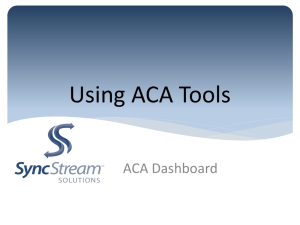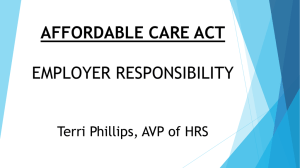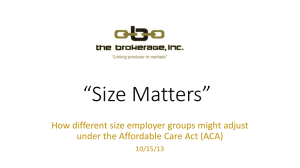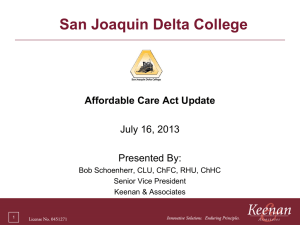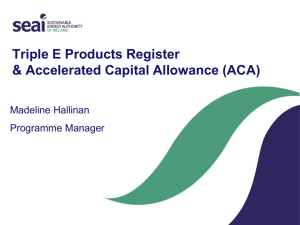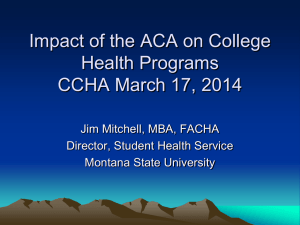ACA-Powerpoint Presentation to Campus
advertisement
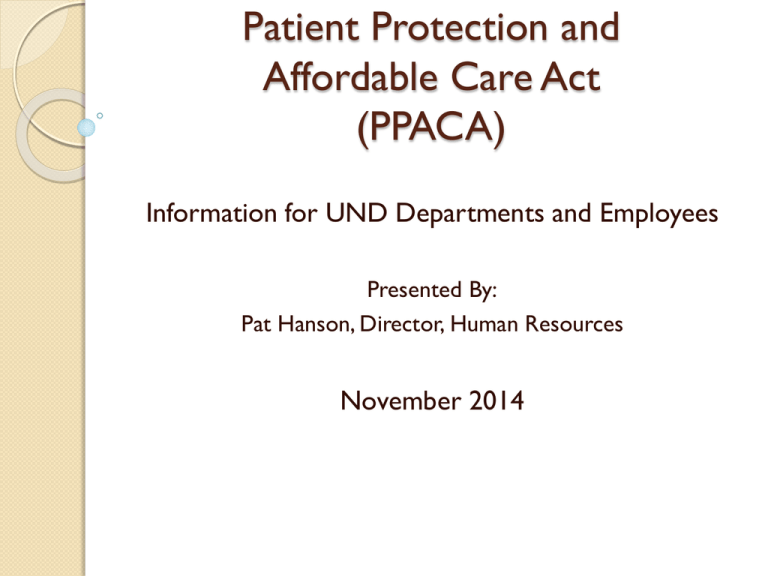
Patient Protection and Affordable Care Act (PPACA) Information for UND Departments and Employees Presented By: Pat Hanson, Director, Human Resources November 2014 Topics to be Covered Affordable Care Act (ACA) Overview ACA Definitions Cost/Penalties ACA Timeline Calculation of Eligibility Next Steps Going Forward Questions Affordable Care Act Provisions Guaranteed Issue/Individual Mandate Benefit and Cost Sharing Standards Public Exchange Availability Consumer Subsidies based on income Employer “Mandate” (Shared Responsibility) Guaranteed Issue The law requires insurance companies to provide what is called "guaranteed-issue" coverage, meaning that insurers can not deny coverage based on past illnesses or current health conditions. Individual Mandate Beginning January 1, 2014, the Affordable Care Act (ACA) requires individuals, who are not exempt, to either maintain minimum essential health insurance coverage for themselves and any nonexempt family members or be assessed a tax penalty: ◦ 2014 – $95 per uninsured person or 1 percent of household income over the filing threshold (whichever is greater) ◦ 2015 – $325 per uninsured person or 2 percent of household income over the filing threshold (whichever is greater) ◦ 2016 – and beyond, $695 per uninsured person or 2.5 percent of household income over the filing threshold (whichever is greater) ◦ 2017 – going forward, the penalties will be increased by the cost-of-living adjustment Benefit and Cost Sharing Standards Standardized essential health benefits must be provided by all plans (exception for grandfathered health plans-NDPERS) Standardized cost sharing of health benefit costs between insured and the insurance company ◦ Services must be covered at specific cost sharing rates – Certain preventive care services must be covered in full Public Exchange Availability The Affordable Care Act (ACA) introduces a new option for small business employers and individuals to access health insurance, Health Insurance Marketplaces, also called Exchanges. The next open enrollment period for plans offered through the Individual Marketplaces starts Nov. 15, 2014, and ends Feb. 15, 2015. To qualify for subsidies, the individual may not be eligible for affordable health care through their employer Employer “Mandate” (Shared Responsibility) All employers with 50 or more full-time equivalent (FTE) employees must provide adequate, affordable health insurance to substantially all FTE employees or pay a penalty per full-time employee per year. Coverage must be offered to the employee and dependents (Not spouse). State of North Dakota – One Employer For ACA Purposes Determination has been made that State Agencies and NDUS are ONE employer for calculation of hours worked and penalties When calculating which employees have worked an average of 30 hours or more per week, employment at all State Agencies and NDUS institutions must be included. Definition of FTE Employee Full-Time Employee – Benefited (working in a regularly funded position, 20 hours or more per week and at least 20 weeks per year) Variable Hour Employee* – Non-benefited employee anticipated to average 30 or more hours per week (130+ hours per month/1560+ hours per year) upon hire or during the measurement period Seasonal Employee* – Employed during same season each year, that is more than six months in duration and works more than 1560 hours per year *Includes non-work-study student employees Current Cost of Health Insurance Coverage Per Temporary FTE Employee: $1,108.00 per year ($46.19/pp) Employer: $4,564.88 per year (~$190/pp) Cost is for a single premium only. Employee may purchase dependent coverage at their own expense (Does not cover spouse) – Add’l Cost - $6,107.28. Policy is the same NDPERS policy offered to benefited employees. If employee qualifies for coverage during the measurement period, they will remain eligible for the next plan year, as long as they remain employed, regardless of the number of hours worked. Potential Employer Penalties Must offer coverage to 70% of FTE employees in 2015 and 95% in 2016 Not offering coverage to 70/95% eligible employees AND at least one eligible employee receives a tax credit/subsidy ◦ $2,000.00 per FTE employee Offers coverage to 70/95% eligible employees AND at least one eligible employee receives a tax credit/subsidy ◦ $3,000.00 per FTE employee who qualified for a subsidy Initial ACA Timeline for NDUS Measurement Period: 11/1/2013-10/30/14 ◦ Hours of non-benefited employees (including non-workstudy students) will be tracked to determine if they will be offered ACA Health insurance effective January 1, 2015 Administrative/Open Enrollment Period: 11/1/2014-12/31/2014 Plan Year (Stability Period): 1/1/2015 – 12/31/2015 Measurement Period November 1 – October 31 Eligible employees must have worked an average of 30+ hours per week/130+ per month/1560+ per year) All hours worked by a current temporary employee will be counted-even hours worked as a benefited employee Hours worked prior to a six month break (or a break that exceeds previous time worked) will not be included in annual total Weeks during breaks of 4 weeks to 6 months will not be included in the calculation of average hours worked Calculating Hours Worked Non-benefited Instructors ◦ Hours worked per week will be calculated using 2.67 hours per each hour of teaching or classroom time (includes class preparation time, classroom time, grading papers and additional required meeting & office hours) ◦ Contracts should include all classes taught and hours worked ◦ Hours worked per week will be calculated on a semester or contract basis. FTE/Standard Hours will be updated in HRMS to match the results of that calculation ◦ All Additional Pays MUST have hours worked filled in, if it is payment for additional hours worked ◦ Look Back Period: Additional Pays without hours listed, will need to have hours calculated. Calculating Hours (cont’d) Non-benefitted Coaches ◦ Part-time coaches for recognized sports will be automatically eligible for ACA coverage ◦ Other part-time coaches may be eligible depending on average number of hours worked. Graduate Students ◦ Restricted to working a maximum of 20 hours per week-Ineligible for ACA ◦ Supervisors must be reminded of this restriction ◦ Offered Graduate Health Insurance Calculating Hours (cont’d) Resident Assistants ◦ ACA eligibility dependent on actual number of hours worked Student Employees (Non-Workstudy) ◦ ACA eligibility dependent on actual number of hours worked Workstudy Employees ◦ Not eligible for ACA Next Steps Human Resources is currently calculating hours worked by non-benefitted employees during look back period. Employees eligible for ACA Health Insurance will be notified in writing and offered health insurance Eligible employees must waive or accept coverage in writing by December 5, 2014 Effective December 15, 2014, ACA eligible employees will pay their semi-monthly premium through payroll deduction and employer share will be paid through employer deduction-charged to salary funding source ACA coverage will remain in effect for 12 months, as long as they are still employed. Going Forward Always include hours on Additional pays Be aware of number of hours worked by temporary employees – any employees hired to work more than an average of 30 hours per week will be eligible for ACA coverage upon employment Be aware of current employment by applicants when hiring, ask if they have been, or are currently working, for another State Agency or NDUS institution Last department hiring will be charged ER share Departments CANNOT encourage/ask ACA eligible employees to waive coverage Annual Offer of Coverage Look back period for 2016 started November 1, 2014 Determination of ACA eligibility for all variable hour temporary employees will occur upon hire, 12 months after hire and then at the end of each Measurement period Offers/Waivers must be completed on an annual basis Questions?
